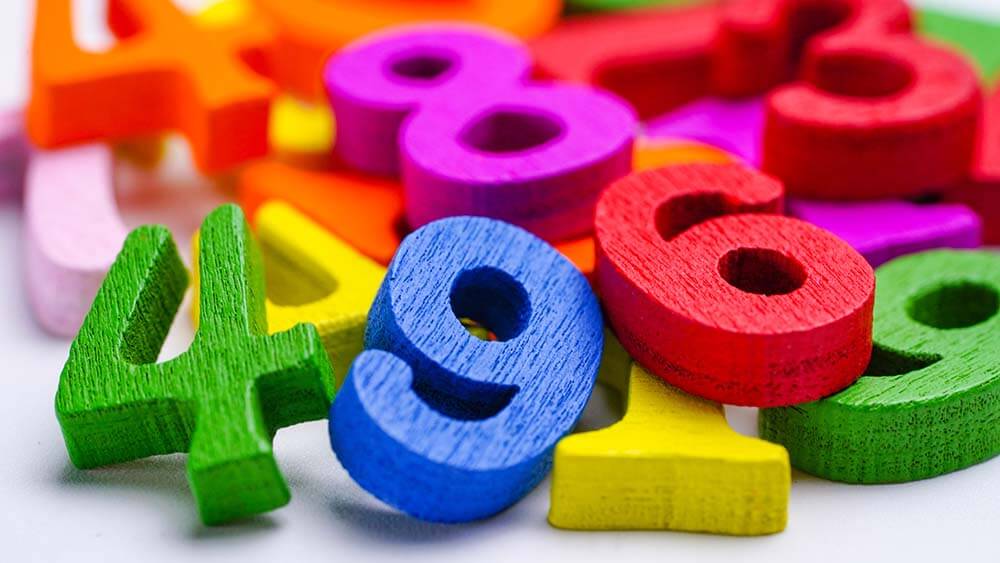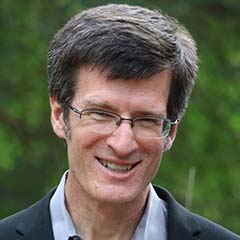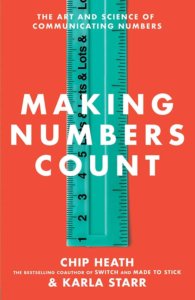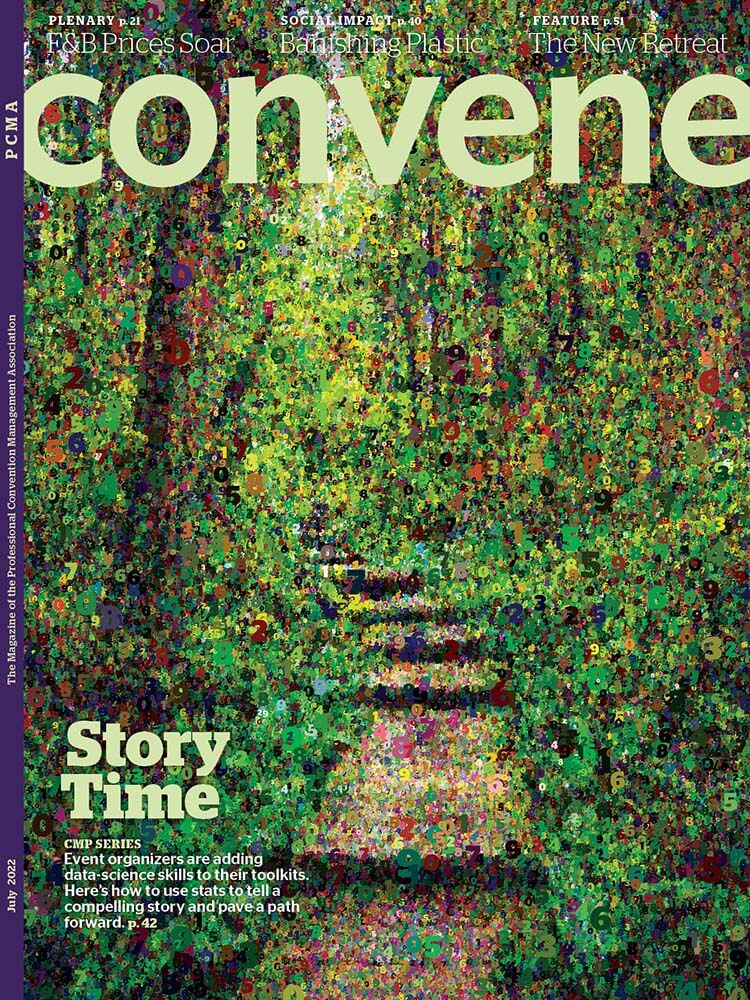
Chip Heath, a professor at Stanford Graduate School of Business, says making numbers concrete allows them to help tell a compelling story — what he calls “bringing out the emotion in numbers.”
No matter how at home you may feel working with spreadsheets, you weren’t built to understand numbers, Chip Heath and Karla Starr write in their new book, Making Numbers Count: The Art and Science of Communicating Numbers. Through much of history, in fact, most languages had no words for numbers greater than five — anything from six to infinity was known as “lots.”
We now have computers to process complex data and numbers in ways our ancestors never could have fathomed — but that doesn’t mean that our brains have caught up. How can we translate millions and billions and milliseconds and nonometers into ideas we can comprehend?
That’s the question Heath, a professor at Stanford Graduate School of Business, sets out to answer in Making Numbers Count. Convene asked Heath, coauthor of four New York Times bestselling books with his brother, Dan, to share what he’s learned about making numbers concrete so that they tell a compelling story — what he calls “bringing out the emotion in numbers.”

We may think we grasp the difference between a million and a billion, but using time as a way to translate that gap — a million seconds is 12 days and a billion seconds is 32 years — packs a wallop.
What prompted you to write the book?
Well, I was actually kind of embarrassed by one of my students, because we [he and brother Dan] wrote a book about sticky ideas [New York Times bestseller Made to Stick] and in that book we said, “Numbers are not very sticky. They’re abstract and good ideas are concrete and they’re complex and good ideas are simple. So [try to] minimize the number of numbers that you use and make things as concrete and simple as possible.”
And one of my students said, “I’m an investment banker. There’s nothing I do other than numbers. Could you give me some more with that?” So, I started adding a session on making numbers stick and it got bigger and bigger as time went on during the next few years. And by the end of the course, I think I came up with something that resonated with students, but it wasn’t easy to do. So that fostered an idea that there may be a bigger book to be written there. And that’s what Karla [Starr, Making Numbers Count coauthor] and I did.
Yes, one of the surprising things for me about the book is you start off by saying, “If possible, avoid using numbers.”
Well, because numbers are complex and abstract, they’re going to be difficult for our brains to grapple with. And so, one of my favorite stats, one of the most terrifying numbers that came up in the book [requires no numbers]: There are more Fortune 500 CEOs named “James” than there are women CEOs. And you look at that, you think, that is just outrageous. And you could get there in another way by saying, “Less than 2.5 percent of Fortune 500 CEOs are women,” but we don’t have any context in our brains for 2.5 percent or whatever the statistic is. And I think the comparison with something that’s a known obscure category is powerful. And that’s what you’re going for [with] a numberless statistic: Can we shock people with a comparison that makes it immediately concrete and emotional, as opposed to going the route of comparing small numbers?
What was the most surprising thing for you that came out of writing this book?
I think the most surprising thing is one for your readers as readers and not necessarily as organization people — it’s just like, there’s a sense of awe and wonder that I took away from a lot of the things that we wrote about. Like the fact that a frog can leap several times its own body size. [Using the Encore method described in the book], you could say that if you could leap like a frog, you would be able to dunk the basketball from the 3-point line — actually, from the 3-point line around your opponent’s basket.
And so, things like that would constantly amaze me — the size of the universe, or the smallness of bacteria, or the quality of athletes and how quickly they can run and react. And so if you understand numbers, you’re more likely to get wowed by the numbers.
I think the organizational implication, the business implication of that is, there may be some numbers buried in our balance sheet somewhere that would wow people if they understood them. But without taking them out and com- paring them with the right comparisons and making them concrete — bringing out the emotion in numbers — we’re not going to get very far.

Because numbers are complex and abstract, they’re going to be difficult for our brains to grapple with.”
The difficulty for someone like me is that often making those translations requires computational ability.
I think it’s a very simple numerical ability, something we covered in our schooling by fourth grade, as opposed to things that we had to take in a calculus course at the university level. I don’t think there’s any math that we use in the book that is harder than fourth-grade math. It’s really more like, are we getting the right comparisons in working through them systematically than you would have to learn fancy math to do this?
What occurred to me after I finished your book is that it shows there’s a need for the human, creative aspect of telling the story of numbers, something machine learning and AI can’t quite do yet.
Machine learning models and AI models are good at doing faster and more effectively things that either arise in the data as big consistencies or things that you knew about from the start. So we can take an algorithm that you know from the start and run it faster on a computer, we can give a computer a narrow structure set of data like pictures of cats and tennis shoes, and teach it in a machine learning model how to divide those things out.
But the thing about those models is, they’re using tons of data. And so they might have to have 750,000 images of cats and tennis shoes to tell them apart. And people aren’t good at processing that much information. Most times in the world, when we’re making a decision, we don’t have that much information. The child who’s learning to tell the cat apart from the dog has got a few observations to go on. And yet they learn to [recognize] a cat without the 750,000 pictures of a cat.
I think in most situations when we have experts doing things that they’re expert on, they’ve got inferences that they’re making from very rare and specialized data. And those are the kind of things that are going to be hard to turf off to a machine learning model.
In what fields do you find people are particularly poor at communicating numbers?
I think basically anybody who was trained to deal with people was probably not trained to deal with numbers. And so as a numbers person in an engineering school, I wasn’t trained to deal with people. I took zero courses on management, negotiation, or persuasion, or presentations. And yet I’ve got colleagues in political science who were thinking about persuasion and looking at the great debates, and the great negotiations of wartime and non-war time.
I think numbers are a skill that you need to invest in. And to do it right, you’ve got to have the analytical skills of an engineer, but also the positioning and framing skills of a political scientist. And there’s no place in a university where that course is taught. That’s what falls in between the cracks of the disciplines: The people who are best at communicating with people don’t know the numbers, and the numbers people don’t know how to communicate it.
Thinking about COVID — we’ve passed a milestone of one million people who have died from COVID in the U.S. and while we’d like to think that COVID is behind us, it’s actually on the rise again in some parts of the world. How can stats like transmission rates make more of an impact with people?
I think people are not good at thinking about rates and they’re not good at thinking about percentages, and the kinds of numbers that go into rates of infection. One person I heard recently said something along the lines of, “Think of COVID as three times as fatal as the flu, but it has the transmission probability of chicken pox.” And if you’re a parent and you’re seeing chicken pox propagate in the elementary school class-room, you know that it’s rapid and spreads quickly. And that notion of three times the flu in terms of the number of people who die is something that’s within our realm of possibilities to think about.
There are two standard moves that you can make in making hard decisions easier, and it’s to make it more concrete and to bring it into the realm of things that people know about. One of my favorite examples in the book is, “40 percent of Americans admit that they don’t wash their hands after using the restroom at home.” And a grad student at Johns Hopkins did a brilliant thing in just saying, “What that means is that two out of the last five people that you shook hands with didn’t wash their hands.”
If you [share the first stat] in a crowd of people, it gets kind of an, “Oh, that’s gross.” But as soon as the graduate student says, “Two out of the last five people that you shook hands with [didn’t wash their hands after using the restroom],” people are reaching for the hand sanitizer. And that’s a good textbook example of taking something that’s abstract — 40 percent — and making it very concrete. And you get a strong reaction when you’re able to do that.
Good numbers not only tell you what to do, they give you motivation to try to change. That’s why Florence Nightingale was so brilliant. …. She didn’t have a degree. She wasn’t a general, she wasn’t a doctor, she wasn’t a noble, and yet she managed to convince generals to change their act in terms of how they were staffing their hospitals and procedures they were doing [to make them more sanitary and safer for soldiers].
She was very aware of the capacity for right comparison, right numbers to be emotional. She said, “We’re killing off more of our soldiers, our frontline soldiers, than the Russians are, and they’re eight times more likely to die from what we do [poor sanitary practices at hospitals] than what the Russians do.”
If you’ve got a thing that’s happening that’s worse than the enemy fighting you — if you’ve got a thing that’s happening that’s worse than the most horrible historical event that we can think of — that’s almost a numberless statistic. That’s because the comparison is so powerful you don’t need the numbers. I think that’s a good thing to keep in mind — the emotional component of numbers. It’s not something we always think about.
Time Is on Your Side
Time is another construct that helps us understand abstract numbers, the Making Numbers Count authors point out. To help consumers understand the advantages of carbon fluorescent lightbulbs (CFLs), you can use a dry version: “CFLs use a quarter of the electricity of standard bulbs and last for seven years in between replacements compared with the ‘replace every year’ cycle for typical bulbs.”
Or you make that span of time more concrete, the authors write, when you say: “Replace your lights with CFLs when your child is learning to walk. The next time you’d have to replace the bulb, your child would be in second grade, learning about oxygen. The next time, they’d be taking driver’s ed.”
 Making You Feel Something
Making You Feel Something
Making Numbers Count has more than 30 principles to help you take dry, incomprehensible numbers and present them in a way that people can immediately understand.
One way to make numbers count is to make them personal, Making Numbers Count authors Chip Heath and Karla Starr say. Here’s an excerpt from the book that explains how.
“Our brains are complex webs of associations and we can access a piece of info in many different ways. The more a new fact connects with the existing network of associations in our brains, the more likely we are to remember it. We might forget an anecdote about a stranger because it makes few connections with our existing associations, but we won’t forget a piece of gossip about our cousin.
“There’s one complex network that is larger and quicker to access than all others — the self. We’ve been thinking about ourselves our whole lives. … So if a new piece of info has something to do with us, it will be more easily and thoroughly processed. …
“The most effective communicators find ways to make the abstract personal. Consider the warning that law schools give to motivate first-year law students concerning the rigors of their program. Hearing that ‘the first-year dropout rate is 33 percent’ is an abstract statistic. ‘Look to your left, look to your right. One of the three of you won’t be joining us next fall’ wakes up the self. We feel something.”
Michelle Russell is editor in chief and Barbara Palmer is deputy editor of Convene.

Convene July 2022 Cover & CMP Series Package
Following are links to other articles from the July cover story:
- Using Event Data to Chart a Path Forward
- Making Emotions Count in Your Event Data
- Where to Start on Your Event Data Journey
- 3 Steps to Impactful Data Storytelling
RELATED CONTENT
- Nancy Duarte’s “3 Ways to Help People Understand What Your Data Means” in the Harvard Business Review
- A five-minute HBR video, “Telling Stories with Data in 3 Steps”
